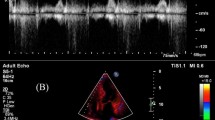Abstract
Right ventricular dysfunction (RVD) is associated with end-organ dysfunction and mortality, but has been an overlooked condition in the ICU. We hypothesized that analysis of the arterial waveform in the presence of ventricular extrasystoles could differentiate patients with RVD from patients with a normally functioning right ventricle, because the 2nd and 3rd post-ectopic beat could reflect right ventricular state (pulmonary transit time) during the preceding ectopy. We retrospectively identified patients with echocardiographic evidence of moderate-to-severe RVD and patients with a normal functioning right ventricle (control) from the MIMIC database. We identified waveform records where ECG and arterial pressure were available in combination, simultaneously with echocardiographic evaluation. Ventricular extrasystoles were visually confirmed and the median systolic blood pressure (SBP) of the 2nd and 3rd post-ectopic beats compared with the median SBP of the ten sinus beats preceding the extrasystole. We identified 34 patients in the control group and 24 patients in the RVD group with ventricular extrasystoles. The mean SBP reduction at the 2nd and 3rd beat was lower in the RVD group compared with the control group [− 1.7 (SD: 1.9) % vs. − 3.6 (SD: 1.9) %, p < 0.001], and this characteristic differentiated RVD subjects from control subjects with an AUC of 0.76 (CI [0.64; 0.89]), with a specificity of 91% and sensitivity of 50%. In this proof-of-concept study, we found that post-extrasystolic ABP characteristics were associated with RVD.





Similar content being viewed by others
References
Simon MA. Assessment and treatment of right ventricular failure. Nat Rev Cardiol. 2013;10:204–18.
Marik PE, Cavallazzi R, Vasu T, Hirani A. Dynamic changes in arterial waveform derived variables and fluid responsiveness in mechanically ventilated patients: a systematic review of the literature. Crit Care Med. 2009;37:2642–7.
Vistisen ST, Juhl-Olsen P. Where are we heading with fluid responsiveness research? Curr Opin Crit Care. 2017;23:318–25.
Vistisen ST. Using extra systoles to predict fluid responsiveness in cardiothoracic critical care patients. J Clin Monit Comput. 2017;31:693–9.
Vistisen ST, Andersen KK, Frederiksen CA, Kirkegaard H. Variations in the pre-ejection period induced by ventricular extra systoles may be feasible to predict fluid responsiveness. J Clin Monit Comput. 2014;28:341–9.
Vistisen ST, Krog MB, Elkmann T, Vallentin MF, Scheeren TWL, Solling C. Extrasystoles for fluid responsiveness prediction in critically ill patients. J Intensive Care 2018;6:52.
Michard F. Changes in arterial pressure during mechanical ventilation. Anesthesiology 2005;103:419–28.
Teboul JL, Vieillard-Baron A. Clinical value of pulse pressure variations in ARDS. Still an unresolved issue? Intensive Care Med. 2005;31:499–500.
Wyler von Ballmoos M, Takala J, Roeck M, et al. Pulse-pressure variation and hemodynamic response in patients with elevated pulmonary artery pressure: a clinical study. Crit Care (London). 2010;14:R111.
Michard F, Richards G, Biais M, Lopes M, Auler JO. Using pulse pressure variation or stroke volume variation to diagnose right ventricular failure? Crit Care (London). 2010;14:451. (author reply 451).
Morgan BC, Martin WE, Hornbein TF, Crawford EW, Guntheroth WG. Hemodynamic effects of intermittent positive pressure respiration. Anesthesiology 1966;27:584–90.
Sarnoff SJ. Myocardial contractility as described by ventricular function curves; observations on Starling’s law of the heart. Physiol Rev. 1955;35:107–22.
Cohn K, Kryda W. The influence of ectopic beats and tachyarrhythmias on stroke volume and cardiac output. J Electrocardiol. 1981;14:207–18.
Johnson AE, Pollard TJ, Shen L, et al. MIMIC-III, a freely accessible critical care database. Sci Data. 2016;3:160035.
Cohen JF, Korevaar DA, Altman DG, et al. STARD 2015 guidelines for reporting diagnostic accuracy studies: explanation and elaboration. BMJ Open. 2016;6:e012799. https://doi.org/10.1136/bmjopen-2016-012799.
Chen C, Lee J, Johnson AE, Mark RG, Celi LA, Danziger J. Right ventricular function, peripheral edema, and acute kidney injury in critical illness. Kidney Int Rep. 2017;2:1059–65.
Cannesson M, Le Manach Y, Hofer CK, Goarin JP, Lehot JJ, Vallet B, Tavernier B. Assessing the diagnostic accuracy of pulse pressure variations for the prediction of fluid responsiveness: a “gray zone” approach. Anesthesiology 2011;115:231–41.
Enevoldsen J, Potes C, Xu-Wilson M, Vistisen ST. Prevalence and temporal distribution of extrasystoles in septic ICU patients: the feasibility of predicting fluid responsiveness using extrasystoles. Crit Care Res Pract 2018. https://doi.org/10.1155/2018/5697092.
Funding
STV is funded by The Danish Medical Research Council (DFF – 4183-00540). BM is funded by Physionet (R01-GM104987-09). LC is funded by National Institute of Health through the NIBIB R01 Grant EB017205. CC is funded by a 3-year Grant: MIT-Philips Research Award; 7/2016-6/2019.
Author information
Authors and Affiliations
Corresponding author
Ethics declarations
Conflict of interest
The authors declare that they have no conflict of interest.
Ethical approval
This study was exclusively observational and based on retrospective analysis of data from the MIMIC III database, which is a public database available for researchers worldwide.
Informed consent
This type of study does not require informed consent from study subjects.
Research involving human participants
The MIMIC database is a public database approved by the US authorities waiving consent from patients, whose data is in the database. The patients are de-identified in this public database.
Electronic supplementary material
Below is the link to the electronic supplementary material.
Rights and permissions
About this article
Cite this article
Vistisen, S.T., Moody, B., Celi, L.A. et al. Post-extrasystolic characteristics in the arterial blood pressure waveform are associated with right ventricular dysfunction in intensive care patients. J Clin Monit Comput 33, 565–571 (2019). https://doi.org/10.1007/s10877-018-0216-2
Received:
Accepted:
Published:
Issue Date:
DOI: https://doi.org/10.1007/s10877-018-0216-2




